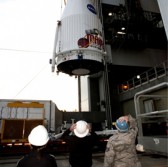 Lockheed Martin flight controllers will oversee the Mars Atmosphere and Volatile Evolution spacecraft’s health and safety functions as the company and NASA prepare for MAVEN to enter Mars’ orbit on Sunday.
Lockheed Martin flight controllers will oversee the Mars Atmosphere and Volatile Evolution spacecraft’s health and safety functions as the company and NASA prepare for MAVEN to enter Mars’ orbit on Sunday.
MAVEN’s orbital insertion concludes its 10-month interplanetary mission and starts its mission to collect data on upper-atmosphere gases on Mars and their interaction with solar winds, NASA said Wednesday.
“The MAVEN science mission focuses on answering questions about where did the water that was present on early Mars go, about where did the carbon dioxide go,” said Bruce Jakosky, MAVEN principal investigator from the Laboratory for Atmospheric and Space Physics at the University of Colorado – Boulder.
“These are important questions for understanding the history of Mars, its climate, and its potential to support at least microbial life.”
NASA says MAVEN will shift into into a 35-hour capture orbit, then enter a six-week phase for NASA and Lockheed to test the spacecraft’s instruments and systems prior to the move into final orbit.
The spacecraft carries three instrument packages from CU-Boulder, NASA’s Goddard Space Flight Center and the Space Sciences Laboratory at the University of California in Berkeley.
Goddard leads the mission and receives support from CU-Boulder (science operations), Lockheed (mission operations) and the Jet Propulsion Laboratory (navigation support and telecommunications relay hardware).




